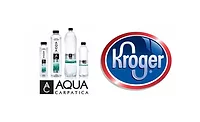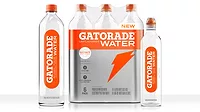Bottled water sees accelerated growth, consumption
Bottled water poised to the be largest beverage category by volume in America by 2017
The International Bottled Water Association (IBWA), Alexandria, Va., in conjunction with New York-based Beverage Marketing Corporation (BMC), released 2015 bottled water statistics, which show that Americans’ consumption of bottled water increased by 7.9 percent and bottled water sales are up 8.9 percent from the previous year, according to the companies.
BMC now indicates that bottled water is poised to overtake carbonated soft drinks as America’s largest beverage category by volume by 2017, if not by the end of 2016, it says.
“Consumer demand for bottled water looks likely to remain strong in the years ahead. Increases in per capita consumption indicate enthusiasm for a product that consumers regard as a healthful alternative to other beverages,” said Michael C. Bellas, BMC chairman and chief executive officer, in a statement. “Americans increased their annual consumption by more than 11 gallons, from 25.4 gallons per person in 2005 to 36.5 gallons a decade later. During the same period, per capita consumption of carbon¬ated soft drinks dropped by 12.4 gallons. Per capita consumption of other major beverage categories, like milk and fruit beverages, also fell.”
Reflecting a clear trend of consumers increasingly choosing healthy, convenient bottled water options, BMC reported that in 2015, the category had achieved a new volume record — almost 3 billion gallons higher than it had been in 2007. Carbonated soft drinks, on the other hand, underwent its 11th consecutive year of volume reductions in 2015, the company says.
Bottled water sales increased by 8.9 percent in 2015, and now total $14.2 billion (wholesale), the company says. In 2015, total U.S. bottled water consumption grew by 7.9 percent to 11.7 billion gallons, up from 10.87 billion gallons in 2014. In addition, per-capita consumption is up 7.1 percent in 2015, with every person in America drinking an average of 36.5 gallons of bottled water last year, it adds.
“There are many attributes that contribute to bottled water’s undeniable appeal to U.S. consumers,” said Chris Hogan, IBWA vice president of communications, in a statement. “Among them are bottled water’s healthfulness, convenience, reliability and safety.”
Bottled water’s versatility makes it suitable for con¬sumption at any time of day and in just about any setting or situation. It doesn’t need to be kept at a particular temperature, and various types of packaging, ranging from 5- and 3-gallon bottles used in homes and offices to single-serve containers sold at retail locations, facilitate a variety of uses, the companies say.
Amid worries about obesity, diabetes and other health matters, bottled water’s lack of calories and ar¬tificial ingredients, convenience and refreshing taste attracts health-conscious consumers, they add.
“Although it has occasionally been compared with tap water, bottled water, in fact, realized its prominence as a healthful choice for consumers seeking to reduce their consumption of other less healthy packaged beverages. While some consumers have turned away from regular, full-calorie sodas in favor of their diet versions, many others transitioned to bottled water instead,” Bellas said.
Additionally, the bottled water industry is continuing to reduce its environmental impact, the companies say. All bottled water containers are 100 percent recyclable and many bottled water companies already are using recycled plastic in bottles.
“Bottled water’s environmental footprint is the lowest of any packaged beverage, according to a life cycle assessment conducted by Quantis in 2010,” Hogan said. “Bottled water has the smallest water and energy use footprint of any packaged beverage. When it comes to overall water use, the bottled water industry is actually a small and efficient water user. Bottled water uses only 0.01 percent of all water used in the U.S.”
The results of a benchmarking study show that the amount of water and energy used to produce bottled water products in North America is less than all other types of packaged beverages, the companies say. On average, only 1.32 liters of water (including the liter of water consumed) and 0.24 mega joules of energy are used to produce one liter of finished bottled water, they add.
The bottled water industry works hard on a number of fronts with recycling advocates, communities, and beverage and food partners to increase recycling rates. In fact, between 2000 and 2014, the average weight of a 16.9-ounce PET bottle declined 51 percent, the association say. This has resulted in a savings of 6.2 billion pounds of PET resin since 2000, the IBWA adds. At 37 percent, percent, the recycling rate for single-serve PET bottled water containers has more than doubled in the past 10 years, and PET bottled water containers are the most frequently recycled PET beverage container in curbside recycling programs.
Looking for a reprint of this article?
From high-res PDFs to custom plaques, order your copy today!





